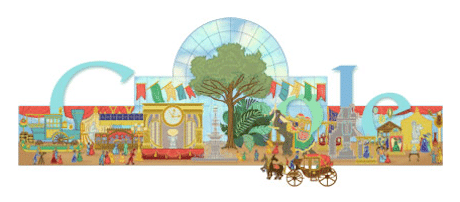
World’s Fair Google Doodle Conceals Treasures of Modern Life
Today Google is honoring the 160th Anniversary of the World’s First Fair. The event took place in Hyde Park in 1851 and was called the Great Exhibition. The event was invented by Queen Victoria’s husband Prince Albert to celebrate modern industrialism and was hosted at the Crystal Palace, a massive glass exhibition centre designed specifically for the event.
Today Google is honoring the 160th Anniversary of the World’s First Fair. The event took place in Hyde Park in 1851 and was called the Great Exhibition. The event was invented by Queen Victoria’s husband Prince Albert to celebrate modern industrialism and was hosted at the Crystal Palace, a massive glass exhibition centre designed specifically for the event.
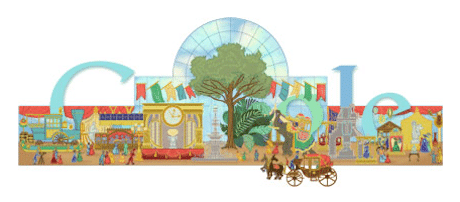
As noted on Earth day, Google Doodles are getting a lot more interactive. Today’s has a zoom feature that allows you to magnify portions of the doodle to find some neat little historical details.
Can you find all the animations?
We’ve found three so far… but there are other elements of the doodle that tell their own story too.
Fountains
Crystal Palace was filled with amazing fountains, but none more so than the Crystal Fountain. Standing at 27 feet tall, the large fountain was capable of shooting water 250 feet in the air, as part of a water system that pumped 120,000 gallons of water.
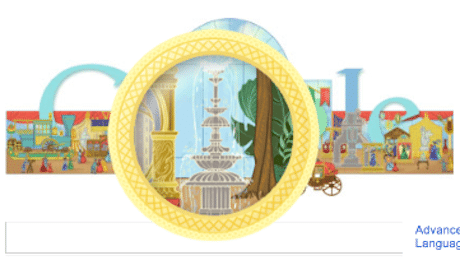
We take fountains for granted now but they were obviously a feat of engineering at the time, requiring engines and a “system of water works”. The Crystal Fountain, “which formed so prominent a feature in the Exhibition of 1851” was super-ceded five years later by The Great Fountains, a “system of water works” designed by Sir Joseph Paxton, also the architect of the Crystal Palace. 11,788 jets of water were pumped by two 40 horse-power engines, which was such a magnificent achievement and source of pride that it was boasted that “their combined effect far excel those of (the palace of) Versailles”.
Diamonds
The animated cogs over the diamond draw attention to the stone itself. It’s the Koh-i-Noor, which was once the largest known diamond in the world. It is also said to be cursed, such that every man who has owned it has had misfortune befall on them or lost their kingdom.
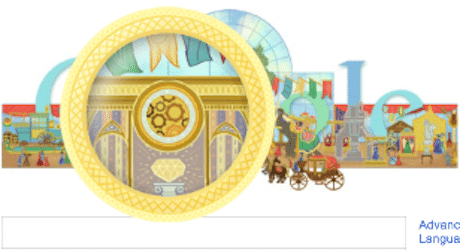
However, the curse apparently has no effect on women which makes the history of the diamond and the presentation at the Great Exhibition even more noteworthy. Fought over for centuries, the diamond was finally seized by the East India Company, the British Empire’s merchant navy, and eventually became part of the British Crown Jewels to be worn by Queen Victoria.
Travel & Photography
The musical notes coming out of the giant steam locomotive draw attention to that section of the doodle. According to the British Library every type of steam engine was on display, celebrating every invention of the era.

Also of interest in that section of the doodle is a man in blue taking a photo at the far left. That is Mathew Brady, a New Yorker, who was awarded a medal at the fair for his early work in daguerreotypes; the first successful photographic process.
Fashion & Transport
The far right of the doodle has an animation of a lady in a green dress, spinning around, which draws attention to the other elements such as the statues, flags, elephant and horse-drawn carriage. In many ways, this section really highlights the sense of modernity shared by all the nations who participated in the Great Exhibition.
The statues came from France, who was also leading manufacturer in textiles, and the revolving lady probably represents the beginnings of the fashion industry, leading to the ‘haute couture’ of today. The royal trappings of the elephant also illustrate the contemporary pride of being in possession of ornate textiles from India.
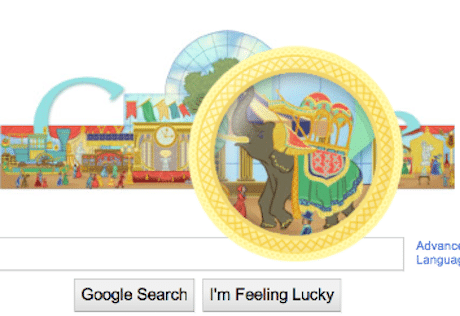
Furthermore, as a mode of transport, the position of the elephant stands in telling contrast to the horse-drawn carriage below it. To get a sense of how modern these inventions must have seemed at the time, just imagine yourself, today, at an automobile show with the latest supercars and concept cars… and then replace that image with horse drawn carriages and every type of steam engine.
Crazy, huh? Lush fountains and blinging diamonds. Long distance travel and photo-journalism. Fashionable clothes and luxury cars. Every invention we understand and take for granted as part of modern culture, now, was first showcased at the Great Exhibition, 160 years ago today (May 1st).
Nice doodle, Google.
This article was originally published in Search Engine Watch on 1st May, 2011.